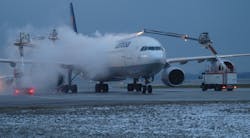A Tour Of The Munich International Airport’s Deicing Recycling Plant
We had the opportunity to take a tour of the Munich International Airport’s Deicing Recycling Plant while attending last October’s inter airport Europe. Here's some of what we heard and saw:
“Recycling is a win-win-win for Munich International Airport,” said Dr. Martin Westermaier, head of application aviation for Clariant during a press conference held prior to the tour. According to his data, the airport currently saves 2 million euros ($2.6 million) each year with its recycling program:
- Recycling deicing fluid avoids the expensive costs normally involved in wastewater treatment of used deicer effluent.
- Using recycled deicing fluid means the airport foregoes the purchase of as much as 2 million liters of new deicing fluid. In fact, the airport’s use of recycled fluid cuts the airport’s orders for new Type I fluid by as much as 70 percent.
Westermaier’s third “win” comes for one more item the airport avoids, in this case, not contributing 15,000 metric tons of carbon emissions. “To put that in perspective,” he added, “that’s the equivalent of 64,000 round-trip flights between Munich and London.”
In another presentation, Erik Johnson, managing director of Atlantic Consulting, backed up Westermaier’s assertions on carbon reduction and added a couple of his own. Johnson studied the procedures at Munich International Airport and other European airports and published his conclusions in a peer-reviewed journal a couple of months before inter airport.
His study concluded that recycling deicing fluid versus not recycling it cuts the footprint of aircraft deicing by as much as 50 percent.
Johnson explained the carbon reduction comes from two ways:
- The carbon footprint of recycling is considerably less than that of manufacturing “fresh” deicing fluid. This accounts for two-thirds of the difference.
- The remaining one-third of the difference comes from avoiding discharges of deicer to wastewater, which creates carbon dioxide as one of the natural, breakdown byproducts.
“Carbon savings of 40 percent to 50 percent is a representative figure for a typical airport in Northern Europe,” Johnson said “In areas where electricity generation is particularly clean, such as in Norway, Sweden or Switzerland, carbon savings will be higher.”
Also, Johnson’s report concluded that recycling conventional petrochemical-based deicer generates as much as a 30 percent lower carbon footprint than using “bio” deicer without recycling.
THE TOUR
After the press conference and a drive to the airport, Thomas Bergstrom, managing director, Aircraft De-icing Engineering, took us for the tour and explained the process. It’d be hard to find a better tour guide: Bergstrom’s been overseeing the recycling plant’s operation since opening day.
A little history lesson may be in order to help explain how recycling deicer came to be in the first place. Munich International Airport opened in 1992, but the planning process for the new airport took 30 years. “Green Parties” in German politics influenced much of the planning, particularly in the 1980s. One big issue was that the airport was to be located in an area with high-level ground water. One legal condition placed on the airport dictated the following:
“The deicing procedures must not affect ground water and any other water within the airport area. It must not harm the sewage treatment plant … the approval of all deicing fluid has to be given by official authorities … unless the deicing fluids and procedures are approved, only nonchemical deicing procedures are allowed or flight operation has to be ceased … “
“This meant that all glycol-contaminated storm water from the aprons, taxiways and runways had to be collected and treated,” Bergstrom said.
Airport management deemed a large investment to increase the capacity of the sewage plant was too much. How else to handle it? A task force came back with a straightforward recommendation: “Recycle the used aircraft deicing fluid for re-use on the airport.”
Recycling used deicing fluid was a relatively new idea at the time, but it was the obvious answer to these restrictions on the airport’s operations. As the idea for building the recycling plant progressed, officials wrestled with a number of operational issues. For one, thickened anti-icing fluids such as Type IV could not be handled; only Type I could be reclaimed and recycled. (Type IV, however, has been pumped into the recycling plant since 2000, but used Type IV gets recycled as Type I.) In order to minimize the use of thickened fluid, deicing needed to be done close to runway heads that assured short hold-over times. Finally, the airport had to minimize the areas used for deicing.
“The solution involved construction of designated deicing pads located close to the runway ends along with a collection system to capture the used fluid,” Bergstrom explained.
The main challenge for these remote deicing pads was that the decision to build them came late in the construction phase of the airport. The runways and taxiways, for example, were already in place. The locations of the pads make it impossible to connect them through a pipeline to the recycling plant.
To handle this situation each deicing pad also is equipped with its own supply station, including storage tanks for Type I and Type IV fluids, refill taps for the deicing vehicles, ready room for staff, control system for pumps, tank-heating equipment and floodlights. The control of the collecting system is also performed from each station.
Eventually the airport built 12 of these deicing pads and supply stations. Approximately 95 percent of all aircraft flying out of the airport are deiced at these sites.
Each deicing pad is supplied with a fleet of Vestergaard deicing vehicles, namely, the Elephant Beta and the Elephant Beta-15. EFM, the airport’s deicing company, nicknamed these vehicles, “polar bears.” Each polar bear can hold approximately 6,000 liters (1,585 gallons) of Type I and 2,000 liters (528 gallons) of Type IV fluid. (EFM also uses the company’s Elephant My for the 5 percent of planes that are deiced on the apron.)
A 2010/2011 report on the deicing season shows that EFM deiced 11,637 aircraft between October 2010 and April 2011. The busiest day was Jan. 24, 2011 when the company deiced 511 planes – a company record.
THE FIRST STEP
All remote deicing pads drain the used fluid into underground tanks. About 60 percent of the fluid is routinely recaptured in this way.
As you can well imagine, the fluid is mixed with plenty of water from melted snow and ice.
“High dilution of the collected fluid creates a water logistics problem,” Bergstrom added, “and the recycling costs rise dramatically.
To combat this, the collected fluid is first sent to small diversion tanks that measure the glycol concentration. Fluid with a 5 percent glycol concentration or more is pumped to another underground tank for transportation to the recycling plant. Concentrations lower than 5 percent are pumped into the storm water retention basin where it is metered to the local sewage treatment plant.
“The 5 percent ‘switch level’ between recycling and not recycling is adjustable,” Bergstrom said. Since an underground piping system couldn’t be built, the collected fluid is transported by trucks to the recycling plant.
Once at the plant, the reclaimed fluid is treated in four steps:
- A mechanical cleaning removes impurities such as sand, oil, aircraft fuel and other “dirt.”
- A chemical cleaning uses absorption and ion exchanger units to remove heavy metals and controls the pH of the fluid. This step essentially results in a water and glycol mix, but which still contains too much water.
- An evaporation process takes care of vaporizing the excess water and, therefore, concentrates the glycol. An interesting side note to this process: The steam produced is fed back by a heat exchanger to the airport’s district heating system. About 90 percent of the energy consumed by the evaporation process is recovered for the heating system.
- When enough water is evaporated and the glycol reaches the correct ratio, it’s pumped into a batch tank. During the pumping, an additive package is dosed into the fluid. These additives are specially designed by Clariant for the process and returns to the fluid the “missing links” so that all specifications for Type I are met.
When one 43,000-liter (11,359 gallons) batch tank is filled, the process switches to the next batch tank. A quality control check on the produced batch is performed. All data is logged and a certificate is made for each batch. One liter from each batch tank is kept for one year at the plant and 0.1 liters is sent to Clariant for backup control.
What can go wrong? Normally, a monitoring system provides an alarm and corrects the process automatically before large volumes are incorrectly produced. However, disapproved fluid is pumped back to the original collecting tanks and processed from the start all over again.
One last quality check is performed when trucks are filled at the plant before transporting the recycled fluid to each of the deicing pad’s supply stations. A sample from each tanker is also kept for one year.
“All fluid movements and data are logged by the recycling personnel,” Bergstrom said. “Due to this system, it is possible to follow the fluid throughout the entire system.”
From start to finish, the recycled fluid can be put back into use in a matter of just a few days.



